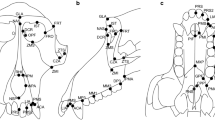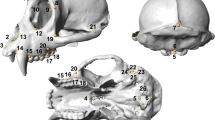Abstract
Multivariate shape analysis of 15 palato-facial measurements of the RusingaD. africanus and MorotoD. major specimens in comparison with apes and monkeys fails to support the hypothesis of special relationship between the dryopithecine species and extant African pongids. TheD. africanus shares with gibbons and cercopithecoids the primitive catarrhine metrical pattern, while chimpanzees and gorillas show a different, derived pattern. TheD. major shows partial convergence on the shape pattern typifying gorillas.
Similar content being viewed by others
References
Andrews, P., 1973. Miocene primates (Pongidae, Hylobatidae) of East Africa. Ph.D. dissertation, Cambridge.
————, 1974. New species ofDryopithecus from Kenya.Nature, 249: 188–190.
Clark, W. E., Le Gros, & L. S. B. Leakey, 1951. The Miocene Hominoidea of East Africa.Fossil Mammals of Africa, vol. 1.
Conroy, G. C. &J. Fleagle, 1972. Locomotor behavior in fossil and living pongids.Nature, 227: 103–104.
Corruccini, R. S., 1975a, Multivariate analysis in biological anthropology: some considerations.J. Hum. Evol., 4: 1–19.
————, 1975b. Morphometric affinities in the forelimb of anthropoid primates.Z. Morph. Anthrop., 67: 19–31.
---- &R. L. Ciochon, 1976. Morphometric affinities of the human shoulder.Am. J. Phys. Anthrop., in press.
————, ————, 1975. Ostemetric shape relationships in the wrist joint of some anthropoids.Folia. primat., 24: 250–274.
----, ----Corruccini, R. S. R. L. Ciochon & ----H. M. McHenry, 1976. The postcranium of Miocene hominoids: were dryopithecines merely “dental apes”?Primates, 17: 205–223.
Delson, E., 1975. Evolutionary history of the Cercopithecidae: In:Szalay Approaches to Primate Paleobiology, Karger, Basel, pp. 167–217.
————, 1975. Evolution and interrelationships of the catarrhine primates. In:Luckett and Szalay Phylogeny of the Primates: A Multidisciplanary Approach, Plenum, New York, pp. 405–446.
Groves, C. P., 1971. Distribution and place of origin of the gorilla.Man, 6: 44–51.
von Koenigswald, G. H. R., 1968. The phylogenetical position of the Hylobatidae. In:Taxonomy and Phylogeny of Old World Primates with References to the Origin of Man,B. Chiarelli (ed.), Rosenberg & Sellier, Torino.
Knussmann, R., 1967.Humerus, Ulna und Radius der Simiae. Bibliotheca Primatologica, No. 5, Karger, Basel.
Lasker, G. W., 1973.Physical Anthropology. Holt, Rinehart, & Winston, New York.
McHenry, H. M. &R. S. Corruccini, 1975. Distal humerus in hominoid evolution.Folia primat., 23: 227–244.
----McHenry, H. M. & ----R. S. Corruccini, 1976. The affinities of tertiary hominoid femora.Folia primat., 26: 139–150.
Morbeck, M. E., 1972. A re-examination of the forelimb of the Miocene Hominoidea. Ph.D. dissertation, Berkeley.
Pilbeam, D. R., 1967. Tertiary pongidae of east Africa. Ph.D. dissertation, Yale.
————, 1969a. Tertiary pongidae of east Africa: evolutionary relationships and taxonomy.Peabody Mus. Bull., 31: 1–185.
————, 1969b. Possible identity of Miocene tali from Kenya.Nature, 223: 648.
Sarich, V. M., 1971. A molecular approach to the question of human origins. In:Background for Man,Dolhinow &Sarich (eds.), Little Brown, Boston, pp. 60–81.
————, 1973. Just how old is the hominid line?Yearb. Phys. Anthrop., 17: 98–112.
Simons, E. L., 1972.Primate Evolution. Macmillan, New York.
————, 1965. Preliminary revision of the Dryopithecinae (Pongidae, Anthropoidea).Folia. primat., 3: 81–152.
----Simons, E. L. & ----D. R. Pilbeam, 1972. Hominoid paleoprimatology. In:The Functional and Evolutionary Biology of Primates,Tuttle (ed.), Aldine-Atherton, Chicago, pp. 36–65.
Simpson, G. G., 1963. The meaning of taxonomic statements. In:Classification and Human Evolution,Washburn (ed.), Aldine, Chicago, pp. 1–31.
Tuttle, R., 1967. Knuckle-walking and the evolution of hominoid hands.Am. J. Phys. Anthrop., 26: 171–206.
Vogel, C., 1966. Morphologische studien am gesichtsschadel catarrhiner primaten.Biblio. Primat., 4: 1–226.
Washburn, S. L., 1968.The Study of Human Evolution. Univ. Oregon Press, Eugene.
————, 1972. Human evolution.Evol. Biol., 6: 349–361.
Wood, B. A., 1974. Locomotor affiinities of hominoid tali from Kenya.Nature, 246: 45–46.
Zwell, M. &G. C. Conroy, 1973. Multivariate analysis of theDryopithecus africanus forelimb.Nature, 244: 373–375.
Author information
Authors and Affiliations
About this article
Cite this article
Corruccini, R.S., Henderson, A.M. Palato-facial comparison ofDryopithecus (Proconsul) with extant catarrhines. Primates 19, 35–44 (1978). https://doi.org/10.1007/BF02373225
Received:
Accepted:
Issue Date:
DOI: https://doi.org/10.1007/BF02373225




